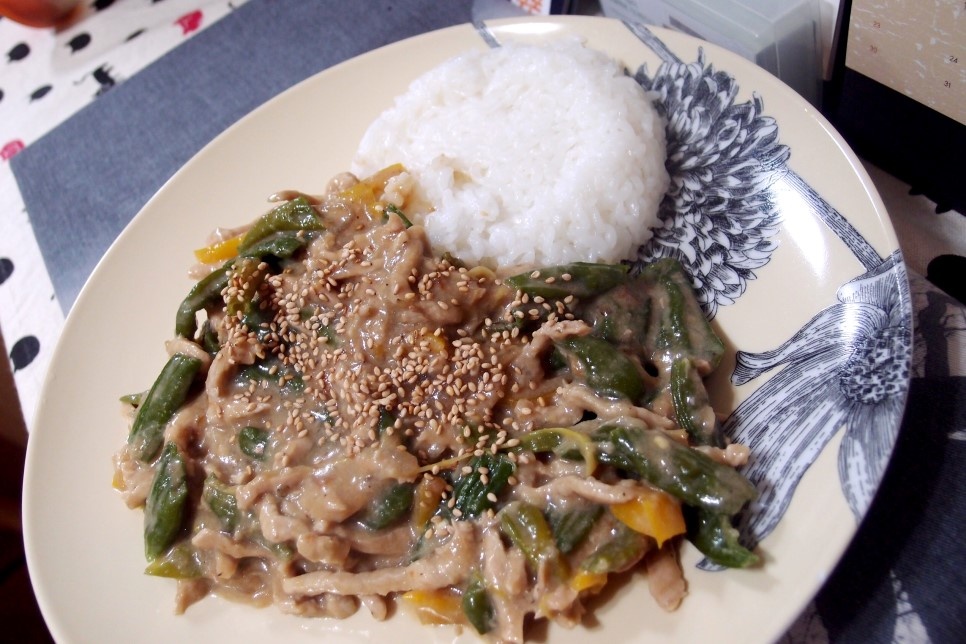Spicy & Savory Snap Pea Stir-fry Rice Bowl
#Homemade #EasyRecipe #SnapPeaDishes #AlcoholPairing #RiceBowl

You can easily make a delicious Gochujapchae (spicy stir-fried peppers) rice bowl, just like from a Chinese restaurant, using snap peas, leftover vegetables from your fridge, and pre-sliced pork for stir-fries. The spicy sauce whets your appetite, making it a great side dish for rice or a perfect accompaniment to drinks. Serve it generously over rice for a delightful meal. Enjoy a rich dining experience with the crisp texture of snap peas and the harmony of various vegetables.
Main Ingredients- 2 bags Snap peas (approx. 400g)
- 400g Pork for stir-fry
Cooking Instructions
Step 1
First, let’s prepare the vegetables for the stir-fry. Using leftover vegetables you have at home will make it even better. For color, we’ll use bell peppers and the essential onion.

Step 2
Wash the onion, peel it, and then slice it into strips about 0.5 cm thick.

Step 3
Similarly, remove the seeds from the bell pepper and slice it into strips about 0.5 cm thick for easy eating.

Step 4
Wash the snap peas thoroughly under running water and remove the stems. Make sure to pat them completely dry, as any remaining water can cause splattering and safety issues when stir-frying.

Step 5
Here are the main ingredients, the snap peas. You can use them whole, or cut them into 2-3 large pieces, depending on your preference. For this recipe, we’ll cut them into large, casual chunks. (Tip: Adding other vegetables like carrots or mushrooms will also be delicious.)

Step 6
It’s convenient to use pre-sliced pork for stir-fries, commonly available at supermarkets. You can use it directly without needing to slice it yourself.

Step 7
Add 1 tablespoon of cornstarch to the pork intended for marinating and mix well. The cornstarch should lightly coat the surface of the meat.

Step 8
Next, add just the egg white from one egg and gently mix it in. Egg white helps make the pork tender and ensures the cornstarch adheres well, allowing the flavors to penetrate deeply.

Step 9
After letting the marinated pork sit for a while, you’ll notice that the cornstarch and egg white have been absorbed, making the meat look more moist and cohesive. Properly marinated pork won’t clump together when stir-fried and will remain tender.

Step 10
Heat a generous amount of cooking oil in a pan. Add plenty of chopped green onions and stir-fry over medium-low heat until fragrant, creating a flavorful green onion oil. This green onion oil is the secret to enhancing the overall aroma of the dish.

Step 11
Once the green onion aroma is strong, add a pinch of ginger powder and stir-fry together to effectively eliminate any pork odor. If you don’t have ginger powder, a little ginger juice can be a good substitute.

Step 12
To add a smoky flavor and the depth of soy sauce, pour 1 teaspoon of soy sauce around the edges of the hot pan in a circular motion. Stir-fry quickly over high heat to caramelize the soy sauce, which will further enhance its flavor.

Step 13
Once the green onion oil and soy sauce aroma have spread throughout the pan, add the marinated pork. Stir-fry rapidly over very high heat. If your ingredients are prepped, the stir-frying process is incredibly fast. Cooking over high heat ensures the meat stays juicy and tender, rather than drying out.

Step 14
When the pork starts to release its cooked aroma, add 1 tablespoon of cooking wine (like soju or mirin) to further remove any gamey smell and allow the alcohol to evaporate. Cooking wine can be used as an alternative.

Step 15
Then, add 1 teaspoon of sugar (or plum syrup) for a touch of sweetness and flavor, and continue to stir-fry over high heat until the pork turns completely gray. Ensuring the pork is fully cooked prevents excess water from releasing when vegetables are added later.

Step 16
Once the pork is cooked, add 1 tablespoon of minced garlic and stir-fry for about 30 seconds until fragrant. Be careful not to overcook the garlic over high heat, as it can burn easily.

Step 17
Now, add all the prepared vegetables, including snap peas, onions, and bell peppers. Stir-fry quickly over high heat with the pork, mixing everything together. It’s important to stir-fry just long enough to keep the vegetables crisp and vibrant, rather than making them soggy.

Step 18
For the first seasoning, add 2 tablespoons of oyster sauce to enhance the umami flavor. Oyster sauce adds a savory depth and slight sweetness, balancing the overall taste. Sprinkle in some black pepper as well.

Step 19
For the second seasoning, add 1 tablespoon of spicy anchovy sauce for a kick of spiciness and deep savoriness. If you don’t have this, you can finish seasoning with soy sauce. Spicy anchovy sauce, while not outwardly spicy, delivers a tingling heat with each bite. Anchovy sauce is excellent for bringing out the inherent flavors of the ingredients.

Step 20
Fill a bowl with warm rice and generously top it with the freshly made snap pea stir-fry. Your delicious Gochujapchae rice bowl is now complete! Mix it with the rice for a slightly milder spicy taste and an even more delightful meal.




